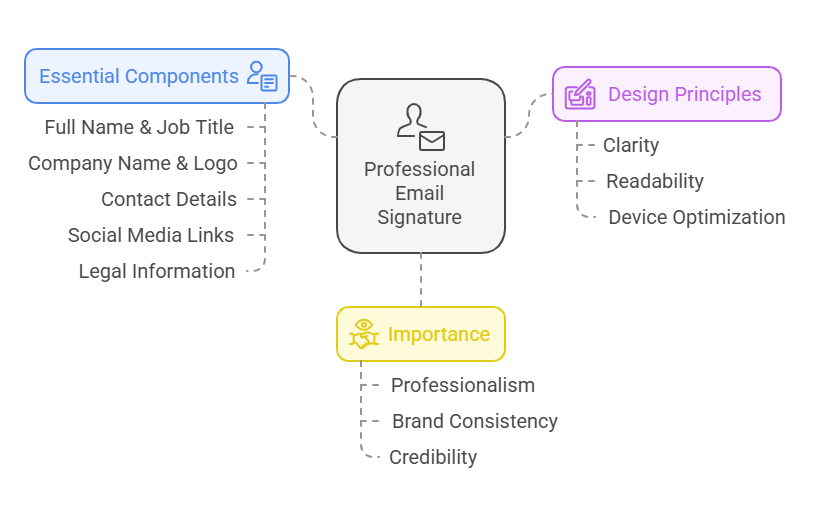We understand that your email signature is more than just a sign-off—it’s a powerful way to enhance your small business branding, improve communication, and build trust with your clients. For small and medium-sized businesses (SMBs) in the UK, crafting a professional email signature that stands out can help you leave a lasting impression, showcase your brand identity, and even drive traffic to your website or social media.
One of our clients, a UK-based recruitment firm, saw a 15% increase in response rates after implementing our customised email signature solutions. Whether you’re aiming to boost engagement or establish a consistent brand image across your team, the right email signature can make all the difference.
In this guide, we’ve put together everything you need to create an effective, mobile-friendly email signature that’s both visually appealing and GDPR-compliant. From integrating logos and links to avoiding common mistakes, we’ll show you how to turn your email signature into a valuable asset for your business.
Whether you’re starting from scratch or looking to refine your existing signature, we’re here to help you get it right.
What makes a professional email signature?
A professional email signature does more than provide contact information; it builds trust, reinforces your brand, and ensures recipients know who you are at a glance. For small and medium businesses (SMBs), crafting the perfect signature can leave a lasting impression and set the tone for future interactions.
Essential components of a professional email signature
An effective email signature is about clarity and impact. These are the key elements every professional signature should include:
- Your full name and job title
Always include your full name and job title to clearly communicate your identity and role within the company. This basic detail establishes credibility and ensures recipients understand your authority on the subject. - Company name and logo
Featuring your company name and a well-placed logo helps create brand recognition and reinforces professionalism. Opt for a high-quality logo that scales correctly across different email clients and devices to maintain a polished appearance. - Contact details
Provide essential contact details like your phone number, email address, and a hyperlink to your website. These details make it easy for recipients to reach you directly or explore your services further. Hyperlinking simplifies the process and avoids unnecessary clutter. - Links to social media profiles
Add discreet social media icons linking to your company’s active profiles. Platforms such as LinkedIn or Twitter are excellent for business interactions, and including them can enhance your digital presence without overwhelming your signature. - Legal and compliance information
For UK-based businesses, it’s important to include legal information like your company registration details or GDPR disclaimers. Keep this content concise and in a smaller font to avoid drawing too much attention away from the primary elements.
Designing a signature with clarity and simplicity
The hallmark of a professional email signature is its balance between form and function. It should be visually appealing without distracting from the main message of your email.
Ensure colour contrast meets WCAG guidelines for visually impaired users. For instance, use a contrast ratio of at least 4.5:1 for text against its background. Additionally, implement semantic HTML for screen readers by tagging logos and social media icons with descriptive alt text like ‘Visit our LinkedIn profile’ or ‘Company logo.’ This improves usability for all recipients, including those relying on assistive technologies.
- Prioritise readability
Arrange the elements of your signature to ensure the most critical information – your name, role, and contact details – is easy to find at a glance. Using consistent font styles and sizes throughout your signature creates a cohesive look. - Avoid unnecessary embellishments
While it might be tempting to include quotes, too many links, or large promotional banners, these can detract from the professionalism of your signature. Aim for simplicity, keeping your design clean and focused. - Optimise for all devices
Many email recipients will view your signature on a mobile device. Ensure the design adjusts seamlessly to smaller screens, with fonts and icons that remain readable and clickable. Place your logo to the left or centre to balance the design, ensuring it’s not too large or overpowering. Design your email signature to be fully responsive and test on various platforms like Gmail and Outlook to catch issues before deployment.
Why every detail matters
Every email you send is an opportunity to reinforce your professionalism. A clean, cohesive email signature reflects your attention to detail and creates a sense of reliability and trustworthiness. By thoughtfully incorporating these elements into your signature, you not only provide practical contact details but also enhance your brand’s image and build credibility.
Understanding how to align your email signature with your company’s branding ensures every email reflects your professionalism and supports consistent communication across your team.
How to align your email signature with your brand
For small and medium businesses, consistency is the cornerstone of strong branding. Every interaction with a client, partner, or prospect—including email communication—should reflect your company’s identity. A well-aligned email signature ensures that your brand is instantly recognisable and reinforces professionalism.
Reflecting your brand identity
Your email signature should echo the look and feel of your overall branding. This alignment helps establish trust and familiarity with recipients.
Example 1: Recruitment – How branding boosts client confidence
Consider a recruitment agency sending follow-up emails to potential clients. A professional signature featuring the agency’s logo, brand colours, and a tagline like “Matching talent to opportunity” instantly conveys credibility. By including a clickable LinkedIn icon, clients can view testimonials or explore their active job postings, building trust. This seamless branding encourages recipients to engage further—whether it’s booking a consultation or reaching out for more information.
Example 2: Food and beverage service activities
Imagine a catering company following up with potential clients for an event. A professional signature featuring a sleek logo, a tagline like “Making Every Event Delicious,” and a clickable menu link instantly conveys their commitment to quality. Including a QR code for a sample menu or testimonials adds an interactive touch, encouraging recipients to explore their services further.
Example 3: Manufacturing and certifications
A precision parts supplier includes certifications like ISO 9001 and a tagline such as “Delivering Quality You Can Trust.” Their email signature reinforces trustworthiness and demonstrates compliance, giving recipients confidence in their services. Adding a clickable link to their certification documents or product catalogue makes it easy for potential clients to access critical information.
Example 4: Real estate and property listings
A boutique real estate agency’s email signature features a dynamic banner with the text “Discover Our Latest Listings.” The banner links directly to their website’s property search page, driving engagement. Including a QR code for virtual tours of featured properties adds a modern touch, appealing to busy homebuyers and investors. For a property management firm, a CTA like ‘Explore Luxury Rentals’ with a clickable link to top listings can increase engagement.
- Colours and fonts
Use your brand’s colour palette sparingly in the signature to highlight key elements, such as your name or company logo. Stick to professional fonts that are easy to read, like Arial, Calibri, or Verdana, and ensure the font size is consistent across devices. - Taglines and messaging
If your business uses a tagline, consider adding it subtly beneath your logo or contact information. This reinforces your brand’s values or mission without dominating the signature. - Logos and visuals
Incorporate your logo as a central visual element, ensuring it is high-quality and appropriately sized. Avoid using stretched or pixelated images, as these can detract from the professional appearance of your emails.
Maintaining consistency across your team
For SMBs, team-wide consistency in email signatures is critical. When every employee uses a uniform design, it strengthens your brand and ensures a cohesive image in all communications.
- Standardised templates
Create a single template for all team members to use, ensuring that key elements like the logo, font, and structure remain uniform. Tools like Exclaimer or WiseStamp can help centralise and automate this process. - Role-specific adjustments
While the overall design should remain the same, you can customise certain details for different departments. For example, sales staff might include a direct booking link, while customer service might highlight support contact details. - Training and implementation
Educate your team on the importance of maintaining consistent signatures and provide them with the necessary resources, such as step-by-step setup instructions or ready-made templates.
Adding a personal touch while staying professional
Although consistency is key, there’s still room for individuality. Allow team members to include details that make their signatures personal yet professional.
- Social media profiles
Encourage employees to include links to their professional LinkedIn profiles if relevant to their role. This adds a personal touch while keeping interactions business-focused. - Job-specific highlights
Certain roles may benefit from additional elements, like a booking link for sales teams or a calendar invite for consultants. Ensure these additions are subtle and don’t overwhelm the design.
Why alignment matters
An email signature that aligns with your brand does more than create a uniform appearance – it communicates reliability, professionalism, and attention to detail. It ensures that every email sent reinforces your company’s identity, helping your business leave a positive, lasting impression.
The right tools can make creating and managing professional email signatures effortless. Here’s a look at some of the best options for small and medium businesses.
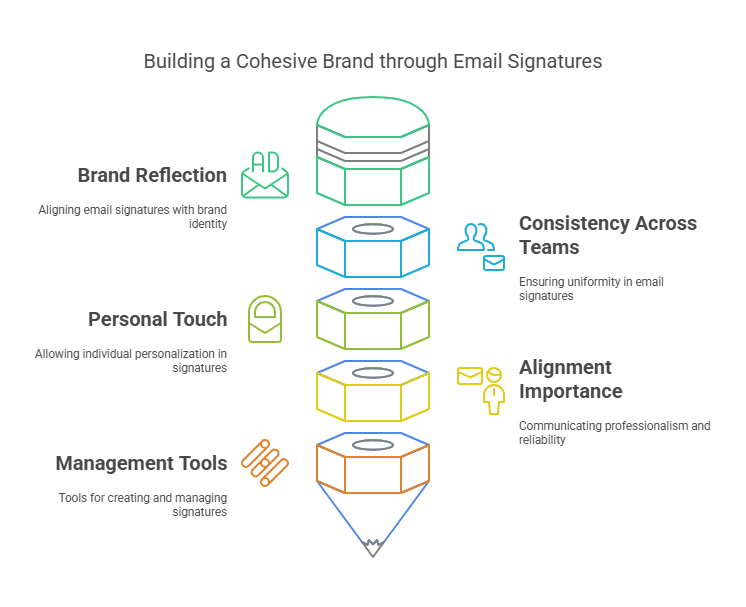
Tools for creating and managing email signatures
Designing and maintaining consistent email signatures across your team can be a daunting task, especially for small and medium businesses. Fortunately, a range of tools can simplify this process, ensuring your signatures remain professional, branded, and compliant.
Tools for small and medium businesses
Here are some of the best tools for creating and managing email signatures, tailored to the needs of SMBs:
- Exclaimer
A market leader in email signature management, Exclaimer allows you to centralise signature creation and deployment. With its user-friendly interface, you can create consistent, brand-aligned signatures across your organisation, ensuring everyone stays on message. - WiseStamp
WiseStamp is a versatile tool offering dynamic and visually appealing email signature templates. It’s ideal for SMBs looking to integrate social media links, promotional banners, or dynamic content, such as upcoming events or special offers. - Rocketseed
This platform specialises in marketing-focused email signatures. With Rocketseed, you can track engagement metrics, integrate dynamic content, and ensure every email acts as an extension of your marketing efforts. - HubSpot Email Signature Generator
Perfect for teams on a budget, this free tool offers basic templates to create simple, professional signatures. While it lacks advanced features, it’s an excellent option for businesses getting started. - MySignature
MySignature provides customisable templates that are easy to integrate with major email clients like Gmail, Outlook, and Apple Mail. It’s a great choice for businesses looking to balance simplicity with branding.
Setting Up Email Signatures in Outlook and Gmail
Here’s a quick step-by-step guide:
- Outlook: Go to File > Options > Mail > Signatures, then create or edit your signature and save it.
- Gmail: Open Settings > General > Signature, then paste or design your signature using the editor. Use guides like Microsoft Support or Google Help for more detailed instructions.
Benefits of centralised signature management
Using a centralised system to manage email signatures offers significant advantages, particularly for growing SMBs:
- Consistency across the organisation
Centralised tools ensure every employee uses the same signature format, maintaining a cohesive brand identity in all communications. - Easy updates and scalability
With a single platform, you can roll out updates—such as new logos, taglines, or disclaimers—across your team instantly, saving time and reducing errors. - Marketing opportunities
Tools like Exclaimer and Rocketseed allow you to add banners or dynamic CTAs to promote events, products, or special offers, turning every email into a marketing opportunity. - Compliance assurance
Many tools ensure that legal disclaimers, privacy policies, and other compliance elements are consistently included in all signatures, helping you meet GDPR and industry requirements.
Choosing the right tool for your business
The ideal tool depends on your business size, goals, and budget:
- For businesses prioritising branding and consistency, Exclaimer or Rocketseed are excellent choices.
- If you’re looking for cost-effective solutions, WiseStamp or MySignature provide affordable yet professional options.
- For those needing simplicity and functionality without cost, the HubSpot Email Signature Generator is a good starting point.
Maximising your investment
Whichever tool you choose, ensure you take the time to set up your signatures correctly. Test them across different email clients and devices to ensure they appear as intended and are fully functional. Provide your team with clear guidelines on using the signature templates to avoid any deviations.
Optimising your email signature for mobile devices is no longer optional. With the majority of emails being read on smartphones, it’s crucial to ensure your signature looks polished on every screen.
Experiment with A/B testing elements like CTA wording, banner placement, or colour schemes to determine what drives the most engagement. For example, test ‘Learn More’ vs ‘Explore Our Services’ as call-to-action text. Use tools like Rocketseed to track performance and refine designs for maximum impact.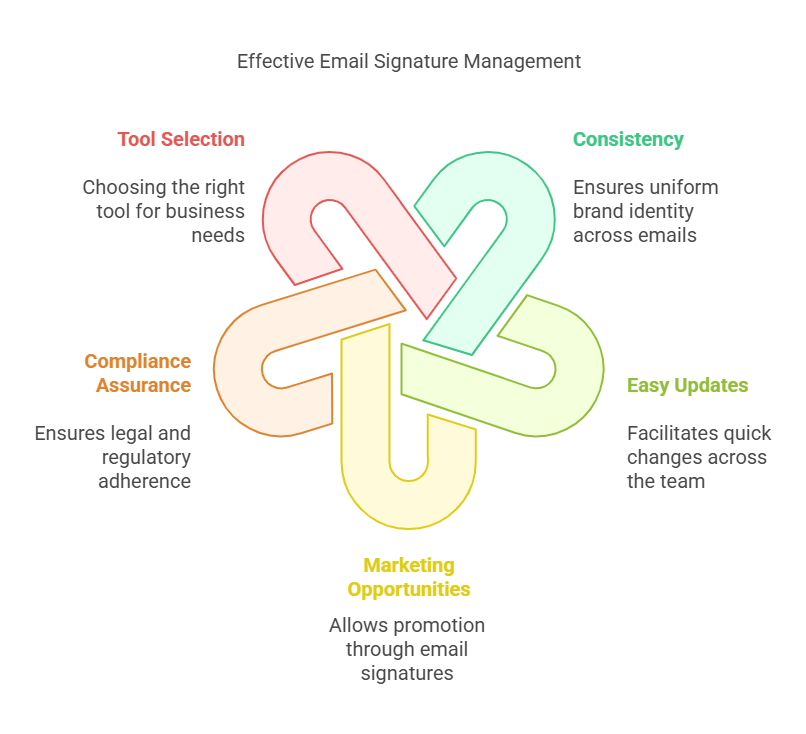
How to optimise email signatures for mobile devices
With more than half of all emails opened on smartphones and tablets, ensuring your email signature looks great on mobile devices is no longer optional – it’s essential. A poorly optimised signature can appear cluttered, difficult to read, or even broken on smaller screens, leaving a negative impression. Here’s how to ensure your email signature is mobile-friendly and professional.
Keep it simple and responsive
The key to a mobile-friendly email signature is simplicity. A clean design adapts better to different screen sizes and ensures the essential information is clear.
- Avoid excessive text
Stick to the most important details – your name, job title, company name, contact details, and a logo. Too much text can appear cramped or difficult to read on smaller screens. - Use a responsive layout
Ensure your email signature adjusts automatically to different devices. Responsive design formats elements like logos and contact details to stack vertically when viewed on narrow screens, preserving readability. - Test across devices
Before rolling out your signature, test its appearance on popular devices and email clients like Gmail, Outlook, and Apple Mail. This will help identify and fix any alignment or formatting issues.
Optimise images for mobile
Visual elements like logos or social media icons add a professional touch to your signature, but they must be optimised for mobile displays.
- Use appropriately sized images
Large images can take up excessive space or fail to load properly on mobile devices. Stick to small, lightweight files – ideally no larger than 100 KB. - Ensure sharp resolution
Use high-quality PNG images with a transparent background to ensure logos and icons look crisp on high-resolution screens. - Avoid reliance on images for critical details
Contact information or links should always be in text form to remain functional even if images fail to load.
Prioritise clickability
Mobile users rely heavily on touch interactions, so your email signature should be easy to navigate with a finger.
- Use large, tappable links
Ensure hyperlinks, phone numbers, and social media icons are spaced far enough apart to be easily clicked without accidental errors. - Include clear call-to-actions
Add a clickable website link or a “Book a Call” button, making it easy for recipients to take the next step directly from their device.
Design for readability
Small screens demand extra attention to font size, spacing, and colour contrast to maintain readability.
- Choose readable fonts
Stick to web-safe fonts like Arial, Calibri, or Verdana, which render consistently across devices and email clients. Use a font size of 10–12 points for text to ensure readability on smaller screens. - Use contrasting colours
Ensure text and background colours contrast sufficiently for easy reading. For example, dark text on a light background works well. Avoid overly bright or clashing colours that can strain the eyes.
Example: Digital and creative industries
A digital marketing firm relies on email signatures that are optimised for smartphones. With a clean layout, tappable phone numbers, and a clickable portfolio link, their signature ensures seamless interaction for busy clients on the go. The mobile-friendly design reflects their technical expertise and boosts engagement by making it easy to explore their services with a single tap.
Benefits of mobile-friendly email signatures
By optimising your email signature for mobile, you ensure that your communications look polished and professional on every device. A responsive design improves the user experience, reinforces your brand, and prevents issues like broken layouts or illegible text that could damage your credibility.
Avoiding common mistakes can make the difference between a professional email signature and one that misses the mark. Here are key pitfalls to watch out for and how to address them.
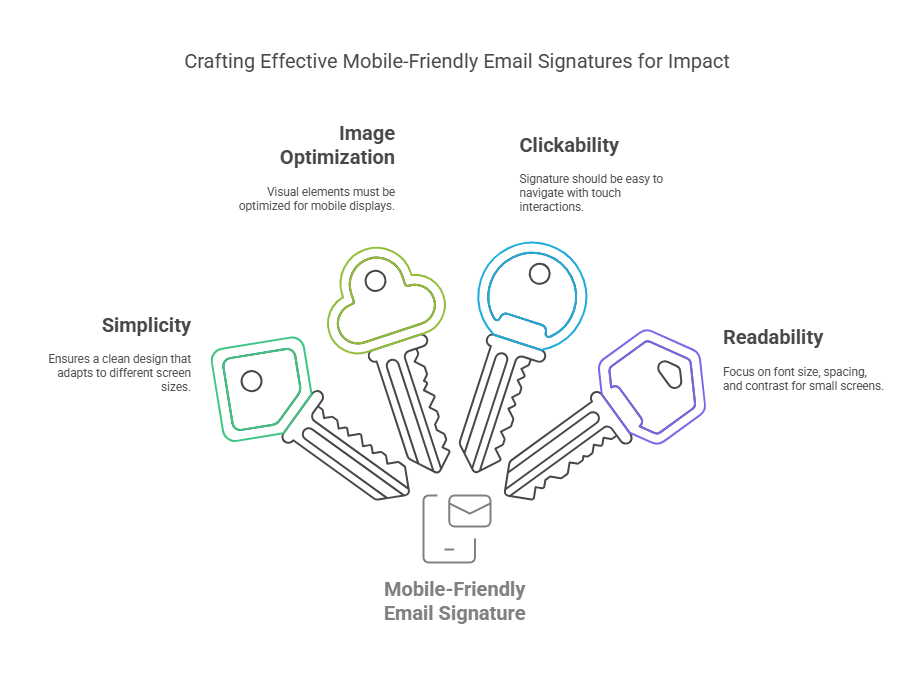
Common mistakes to avoid in email signatures
Even with the best intentions, it’s easy to make mistakes when designing email signatures. These oversights can detract from your professionalism, compromise branding, or even affect email deliverability. By avoiding the following common pitfalls, you can ensure your email signature leaves a positive impression.
Overloading the design with unnecessary details
One of the most frequent mistakes is including too much information, which can overwhelm recipients and make your signature appear cluttered.
- Too many links or promotional elements
While adding links to your website or social media profiles is important, overloading your signature with multiple links, banners, or CTAs can dilute the message and distract the reader. Stick to the essentials. - Personal quotes or irrelevant content
Including inspirational quotes or unrelated messages may feel personable but can come across as unprofessional, especially in a business context.
Example: Healthcare and assistive technology
A private healthcare provider overwhelms their email signature with too many links—patient portals, feedback forms, and promotional materials—making it difficult for recipients to navigate. Simplifying the signature to include just the clinic’s logo, a direct booking link, and contact details improves clarity and ensures patients can quickly find what they need.
Using low-quality visuals
Images are a key part of a professional email signature, but if they’re poorly optimised, they can harm your brand image.
- Pixelated or oversized logos
A low-resolution logo appears unprofessional, while oversized visuals can distort your signature layout and cause slow email load times. Always use high-quality, properly scaled images. - Inconsistent branding
Using mismatched colours, logos, or fonts can confuse recipients and undermine your brand identity. Ensure all visual elements align with your company’s brand guidelines.
Neglecting mobile optimisation
Given the prevalence of mobile email usage, failing to optimise your signature for smaller screens is a missed opportunity.
- Fixed-width designs
A signature that doesn’t adapt to different screen sizes can appear broken or cut off on mobile devices. Always test your design for responsiveness. - Hard-to-click links or icons
Small, tightly packed links are difficult to tap on mobile devices. Ensure sufficient spacing and use touch-friendly designs.
Ignoring compliance and deliverability considerations
Legal and technical oversights can cause your emails to appear untrustworthy or even get flagged as spam.
- Missing legal disclaimers
In the UK, email signatures may require legal information such as company registration numbers or GDPR disclaimers. Omitting these can result in compliance issues. - Triggering spam filters
Using large images, excessive links, or certain keywords can cause your email to be marked as spam. Keep your design simple and use a text-to-image balance that avoids triggering filters. - Skipping SPF, DKIM, and DMARC setup
These email authentication protocols ensure your emails are delivered securely and don’t end up in spam folders. Coordinate with your IT team to implement them correctly.
Failing to test your email signature
Without thorough testing, even a well-designed signature can fail to perform as intended.
- Skipping multi-client testing
Signatures may look perfect on one email client but broken on another. Test your signature across Gmail, Outlook, Apple Mail, and other platforms to ensure compatibility. - Forgetting about dark mode
With the growing use of dark mode, signatures that rely on light colours may become difficult to read. Design with both light and dark modes in mind to maintain clarity.
Why avoiding these mistakes matters
A poorly designed email signature doesn’t just reflect badly on your brand—it can also reduce trust, hurt engagement, and complicate communication. By sidestepping these common errors, you ensure that your emails project professionalism, reinforce your branding, and deliver a seamless experience for recipients.
Next, we’ll look at how to ensure compliance and enhance deliverability, addressing key legal and technical considerations for UK businesses. Let’s keep your signatures both effective and trustworthy.
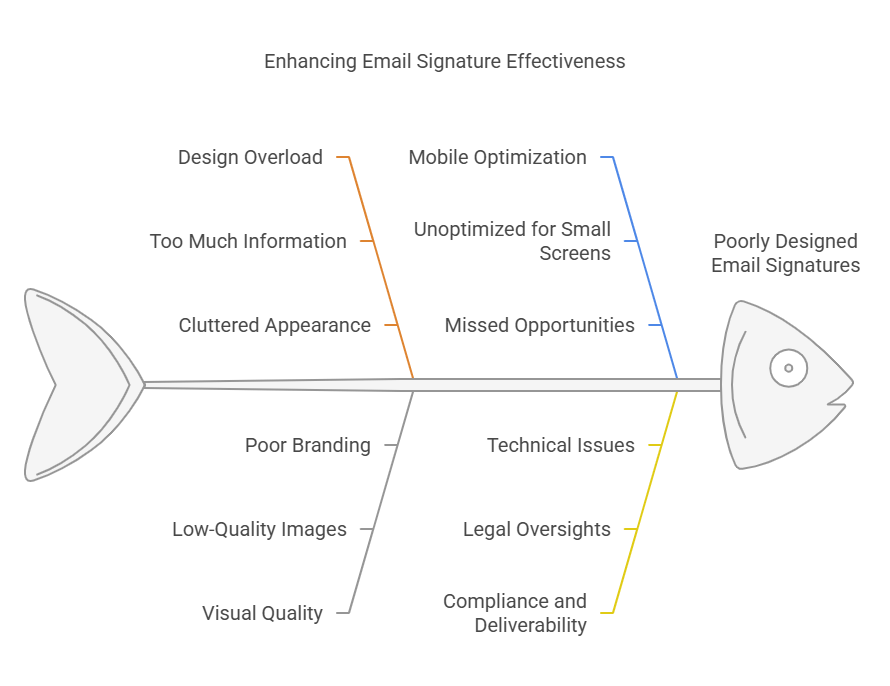
Ensuring compliance and enhancing deliverability
A professional email signature must not only look good but also adhere to legal requirements and avoid technical pitfalls that could impact deliverability. For small and medium businesses in the UK, compliance with GDPR and maintaining secure email practices are crucial for protecting your reputation and ensuring that your messages reach their recipients.
Meeting legal and regulatory requirements
UK businesses need to include specific legal details in their email signatures to comply with regulations such as GDPR and the Companies Act. Regardless of industry – whether you’re in legal services, retail, manufacturing, or healthcare – ensuring compliance with GDPR and other regulations fosters trust and professionalism. Including disclaimers and privacy policy links reassures clients of your commitment to security and transparency.
- Include legal identifiers
Your email signature should clearly state your company name, registration number, and registered office address. These details are particularly important for limited companies operating in the UK. - Add a GDPR disclaimer
If your emails involve personal data, include a brief statement explaining how you process and protect that data. Instead of adding a lengthy GDPR disclaimer, include a link to your privacy policy in the email signature. For example, ‘Read our Privacy Policy’ ensures compliance while maintaining a clean, professional design.
Example: Legal and accounting firms
A small accounting firm includes a GDPR-compliant disclaimer in their email signature, clearly stating how client data is processed and protected. This transparency reassures clients about the firm’s professionalism and compliance with data regulations, fostering trust in their services.
- Use confidentiality notices where appropriate
For sensitive communications, include a disclaimer that the email is intended only for the recipient and should not be shared without permission.
Enhancing email deliverability
A well-designed signature can still end up in a recipient’s spam folder if certain technical safeguards aren’t in place. Implement these best practices to ensure reliable delivery:
- Set up SPF, DKIM, and DMARC
These email authentication protocols work together to verify that your emails are legitimate and protect against spoofing:- SPF (Sender Policy Framework): Authorises your email server to send messages on your domain’s behalf.
- DKIM (DomainKeys Identified Mail): Adds a digital signature to your emails to verify their authenticity.
- DMARC (Domain-based Message Authentication, Reporting, and Conformance): Provides instructions to email providers on handling unauthenticated messages.
- Balance text and images
Emails with too many images or not enough text can trigger spam filters. Maintain a healthy ratio to avoid deliverability issues. - Avoid spam-triggering elements
Certain words, excessive links, or overly promotional content can cause spam filters to flag your emails. Use simple, professional language and limit the number of clickable elements in your signature.
Keeping your signatures up to date
Ensuring compliance and deliverability is not a one-time effort. Regularly reviewing and updating your email signatures can help avoid issues and keep your communications aligned with your company’s evolving needs.
- Conduct regular audits
Periodically review all employee email signatures to ensure compliance with legal requirements and consistency with your branding. - Update legal and promotional content
Ensure that any links to policies, promotional banners, or disclaimers reflect the latest company information. - Test new designs
Before rolling out updates, test the new signatures across platforms and devices to ensure they perform as expected.
Why compliance and deliverability matter
Failing to address legal requirements or deliverability issues can damage your reputation, create legal risks, and reduce the effectiveness of your communications. By prioritising compliance and implementing best practices, you not only protect your business but also enhance trust and professionalism in your email interactions.
To make your email signature truly stand out, adopting innovative design trends and interactive features is essential. These approaches can help showcase your brand’s creativity and engage your audience effectively.
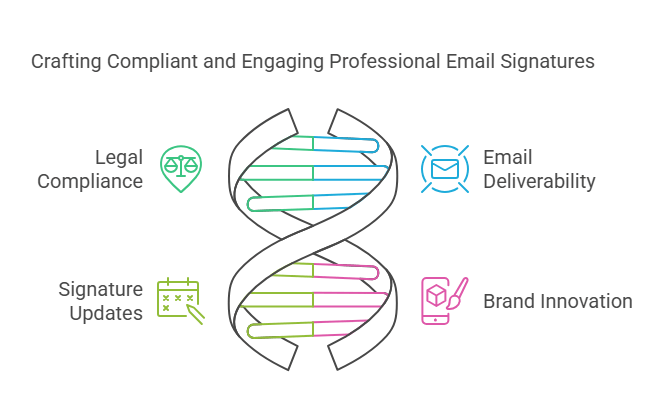
Innovative trends in email signature design
To make your email signature stand out in a crowded inbox, incorporating modern design trends and interactive features is key. While maintaining professionalism, these innovations can enhance engagement, drive traffic, and showcase your brand’s forward-thinking approach. Let’s explore the latest trends shaping email signature design.
Dynamic banners and call-to-actions (CTAs)
Email signatures are no longer static—they can be a powerful marketing tool. Adding dynamic banners or CTAs to your signature helps keep recipients engaged and aligned with your business goals.
Example: Retail trade
A boutique retailer uses a CTA banner in their email signature with the message “Shop Our Latest Collection.” The banner links directly to their seasonal catalogue, while a secondary CTA encourages recipients to sign up for their loyalty programme. This strategic use of email signatures turns every email into a marketing opportunity.
Tailor your signature to the recipient’s industry. For instance, if you’re a salesperson reaching out to healthcare prospects, include a link to a relevant case study, such as ‘How We Helped XYZ Clinic Save Costs.’ If emailing a tech firm, showcase your latest innovation with a banner like ‘Discover Our AI-Driven Solutions.’ This level of personalisation creates a stronger connection and encourages engagement.
- Promote events or offers
Use a clickable banner to highlight webinars, upcoming events, or seasonal promotions. This turns your signature into a subtle yet effective marketing channel. - Example: Advanced manufacturing and engineering
A precision engineering company leverages dynamic banners in their email signature to promote their latest whitepaper on industry trends. Adding a QR code linking to a virtual tour of their facilities creates an engaging experience for potential clients and reinforces their commitment to transparency and cutting-edge innovation. - Drive traffic with tailored CTAs
Examples include “Book Now,” “Learn More,” or “See Our Work.” Ensure your CTAs are relevant to your audience and aligned with your email’s purpose.
To track the performance of email signature links, use UTM parameters. These allow you to measure the traffic and conversions driven by your email signature in tools like Google Analytics.
For example, append your website link with parameters like ?utm_source=email-signature&utm_medium=email&utm_campaign=employee-name. This ensures every click from your email signature can be traced back, helping you measure ROI and optimise future campaigns.
Incorporating QR codes
QR codes provide a convenient way to share additional information without overcrowding your signature.
- Link to your business card
Create a digital business card with key details and contact options. Recipients can save your information with a simple scan. - Showcase products or services
Direct recipients to a landing page, product demo, or a company introduction video. QR codes are a unique way to engage audiences while maintaining a minimalist signature design.
Dark mode compatibility
With the widespread adoption of dark mode in email clients, designing signatures that look great in both light and dark themes is crucial. For example, a signature featuring a transparent logo in PNG format, white text for your name, and dark grey for other details ensures good contrast. Test both light and dark themes across devices to ensure consistent readability.
- Optimise logo and text colours
Use transparent PNGs for logos and choose colours that maintain contrast in both modes. Avoid using white text over transparent backgrounds, as it may become invisible in dark mode. - Test across themes
Regularly check how your signature appears in both light and dark settings on different devices to ensure it remains professional and readable.
Minimalist and eco-conscious designs
Simplicity and sustainability are increasingly important in modern email signature design.
- Go minimalist
Focus on clean lines, essential information, and limited use of colours. Minimalist designs convey professionalism and make your signature easier to read. - Add eco-friendly messaging
Include a small note encouraging recipients to consider the environment before printing emails. This positions your business as socially responsible.
Social proof and interactive elements
Showcasing your company’s credibility and encouraging engagement through interactive elements can further enhance your email signature’s effectiveness.
- Highlight awards or testimonials
Use a small section to showcase recent achievements or client feedback. Keep this subtle and professional. - Integrate interactive elements
Add elements like a clickable video thumbnail, customer review links, or a live social media feed. These features encourage recipients to engage with your business beyond email.
Keeping up with trends while staying professional
While innovation can set your email signature apart, it’s essential to maintain a balance between creativity and professionalism. Choose the trends that best align with your brand and ensure they enhance rather than overwhelm your signature.
Before concluding, let’s tackle frequently asked questions to address common challenges and provide actionable tips for professional email signatures.
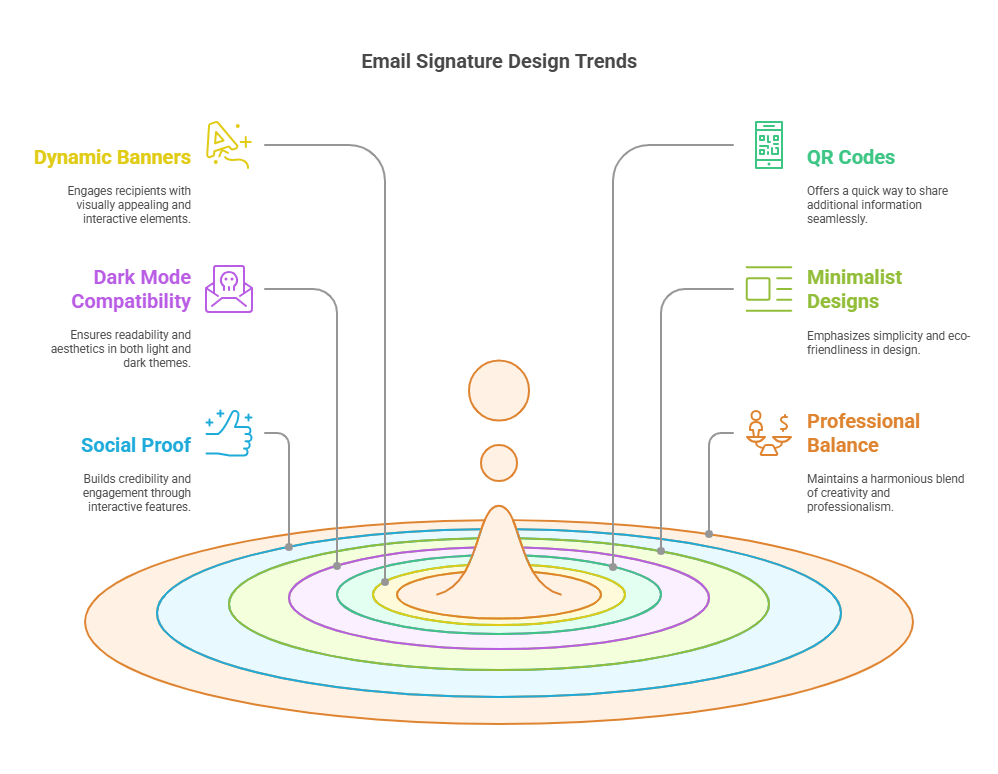
FAQ about email signatures
To address the most common concerns and challenges businesses face, here are answers to frequently asked questions about designing and managing professional email signatures. These practical tips will help ensure your signatures are effective, compliant, and engaging.
Should I include my logo in my email signature?
Yes, including your logo is highly recommended as it reinforces your brand identity and makes your emails instantly recognisable. However, ensure the logo is high-quality, properly sized, and optimised for mobile and desktop email clients. Using a PNG format with a transparent background ensures the logo integrates seamlessly into your design.
How many links should I include in my email signature?
Limit the number of links to maintain clarity and avoid overwhelming recipients. Essential links include your website, key social media profiles, and possibly a call-to-action, such as “Book a Meeting” or “View Our Portfolio.” Too many links can trigger spam filters, so be selective and strategic.
What are the best fonts and sizes for email signatures?
Use web-safe fonts like Arial, Calibri, or Verdana to ensure consistent rendering across all email clients. Keep font sizes between 10 and 12 points for optimal readability on both mobile and desktop devices. Avoid decorative or overly stylised fonts, as they can appear unprofessional and may not display correctly.
How do I make my email signature mobile-friendly?
To optimise your email signature for mobile devices:
- Use responsive designs that adapt to smaller screens.
- Stack elements like logos, text, and icons vertically to ensure readability.
- Ensure links and icons are spaced far enough apart to be easily clickable on touchscreens.
Do I need legal disclaimers in my email signature?
Yes, especially for UK businesses, legal disclaimers can help ensure compliance with GDPR and other regulations. Common disclaimers include confidentiality notices, links to privacy policies, and company registration details. These should be concise and placed at the bottom of the signature in a smaller font size.
Why does my email signature look different on some email clients?
Email clients (e.g., Gmail, Outlook, Apple Mail) interpret HTML differently, which can cause variations in how signatures are displayed. To minimise inconsistencies:
- Test your signature across multiple email platforms.
- Use simple, well-structured HTML.
- Avoid relying solely on images, as they may not load in some email clients.
Can I track the performance of my email signature?
Yes, tools like Exclaimer, Rocketseed, and Wisestamp offer analytics features that allow you to track clicks on links, banners, and call-to-actions. This data helps measure the effectiveness of your signature as a marketing tool and provides insights for optimisation.
How often should I update my email signature?
Review and update your email signature every six months or whenever there are changes to your branding, contact details, or legal requirements. Regular updates keep your signature relevant and aligned with your current marketing objectives.
What’s the best way to roll out email signatures across a team?
Using centralised email signature management tools like Exclaimer or Rocketseed ensures consistent deployment across your organisation. These platforms allow you to create a unified template that can be applied automatically to all team members, saving time and ensuring brand consistency.
What should not be included in a professional email signature?
Avoid cluttering your email signature with excessive links, large promotional banners, or personal quotes, as these can distract recipients and reduce professionalism. Low-quality images and unnecessary personal information like home addresses or unrelated social media links should also be excluded. Keep the focus on essential details that enhance your brand and maintain clarity.
How do logos, images, and links in email signatures affect spam filters?
While logos, images, and links can make email signatures visually appealing, they can also trigger spam filters if overused. To avoid issues, ensure images are optimised for fast loading, keep the number of links minimal, and balance text-to-image ratios. Using email authentication protocols like SPF, DKIM, and DMARC helps improve deliverability and reduces the likelihood of emails being flagged as spam.
What are the GDPR requirements for email signatures in the UK?
To comply with UK GDPR, email signatures should include essential details like your name, role, company name, and contact information. Adding a link to your privacy policy demonstrates transparency in data handling, and any disclaimers should be concise. Avoid including unnecessary personal data, and ensure all legal identifiers, such as the company registration number, are present.
How can SMBs optimise email signatures for accessibility?
Accessible email signatures ensure inclusivity by using high contrast colours for readability and descriptive alt text for images, such as logos or social media icons, to support screen readers. Choose simple, legible fonts like Arial or Verdana and ensure the signature layout adapts well to mobile devices. These steps make your email signature functional for all recipients.
What are the benefits of using dynamic elements in email signatures?
Dynamic elements like banners or QR codes can transform your email signature into a marketing tool. Banners can promote events, offers, or key services, while QR codes provide easy access to resources like product demos or booking forms. These features not only enhance engagement but also allow you to tailor content to your audience, making emails more relevant.
How do consistent email signatures improve brand trust?
Consistent email signatures across an organisation reinforce professionalism and brand identity. A uniform format creates a cohesive image, ensuring all client interactions reflect the same level of quality and attention to detail. This consistency helps establish trust, improve recognition, and streamline communication with customers and partners.
How do you measure the performance of an email signature?
Email signature performance can be measured by tracking metrics like click-through rates on CTAs or links, as well as traffic generated to your website using UTM parameters. Tools like Google Analytics can help you assess how effectively your signature drives engagement or conversions, allowing you to refine it based on data-driven insights.

Conclusion
A professional email signature is a small but impactful part of your business communication. By addressing common challenges, embracing innovative trends, and ensuring compliance, you can create signatures that represent your business at its best and reflect your professionalism in every interaction.
Ready to turn your email signatures into powerful branding and lead-generation tools? At Computercentric, we specialise in crafting GDPR-compliant, mobile-optimised email signatures designed specifically for UK SMBs. With proven strategies that have helped businesses boost website traffic by up to 20% while enhancing brand trust, we’re ready to help your organisation stand out.
Contact us today for a free email signature audit and discover how we can make every email a lasting impression.

